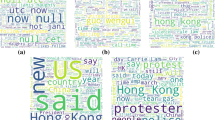Abstract
In this era of information explosion, deceivers use different domains or mediums of information to exploit the users, such as News, Emails, and Tweets. Although numerous research has been done to detect deception in all these domains, information shortage in a new event necessitates these domains to associate with each other to battle deception. To form this association, we propose a feature augmentation method by harnessing the intermediate layer representation of neural models. Our approaches provide an improvement over the self-domain baseline models by up to 6.60%. We find Tweets to be the most helpful information provider for Fake News and Phishing Email detection, whereas News helps most in Tweet Rumour detection. Our analysis provides a useful insight for domain knowledge transfer which can help build a stronger deception detection system than the existing literature.
Access this chapter
Tax calculation will be finalised at checkout
Purchases are for personal use only
Similar content being viewed by others
References
Aassal, A.E., Moraes, L., Baki, S., Das, A., Verma, R.: Anti-phishing pilot at ACM IWSPA 2018 evaluating performance with new metrics for unbalanced datasets, pp. 2–10. http://ceur-ws.org/Vol-2124/#anti-phishing-pilot
Burgoon, J.K., Buller, D.B.: Interpersonal deception: III. Effects of deceit on perceived communication and nonverbal behavior dynamics. J. Nonverbal Behav. 18(2), 155–184 (1994). https://doi.org/10.1007/BF02170076
Devlin, J., Chang, M.W., Lee, K., Toutanova, K.: BERT: pre-training of deep bidirectional transformers for language understanding. ArXiv abs/1810.04805 (2019)
Gautam, A., Jerripothula, K.R.: SGG: Spinbot, grammarly and glove based fake news detection. In: 2020 IEEE Sixth International Conference on Multimedia Big Data (BigMM), pp. 174–182 (2020)
Hernández-Castañeda, Á., Calvo, H., Gelbukh, A., Flores, J.J.G.: Cross-domain deception detection using support vector networks. Soft. Comput. 21(3), 585–595 (2016). https://doi.org/10.1007/s00500-016-2409-2
Hochreiter, S., Schmidhuber, J.: Long short-term memory. Neural Comput. 9(8), 1735–1780 (1997)
Lang, K.: NewsWeeder: learning to filter netnews. In: Proceedings of the Twelfth International Conference on Machine Learning, pp. 331–339 (1995)
Lehmann, J., et al.: DBpedia - a large-scale, multilingual knowledge base extracted from Wikipedia. Semant. Web 6, 167–195 (2015)
Li, J., Ott, M., Cardie, C., Hovy, E.: Towards a general rule for identifying deceptive opinion spam. In: Proceedings of the 52nd Annual Meeting of the Association for Computational Linguistics (Volume 1: Long Papers), Baltimore, Maryland, pp. 1566–1576. Association for Computational Linguistics, June 2014. https://doi.org/10.3115/v1/P14-1147. https://aclanthology.org/P14-1147
Maas, A.L., Daly, R.E., Pham, P.T., Huang, D., Ng, A.Y., Potts, C.: Learning word vectors for sentiment analysis. In: Proceedings of the 49th Annual Meeting of the Association for Computational Linguistics: Human Language Technologies, Portland, Oregon, USA, pp. 142–150. Association for Computational Linguistics, June 2011. http://www.aclweb.org/anthology/P11-1015
Pérez-Rosas, V., Kleinberg, B., Lefevre, A., Mihalcea, R.: Automatic detection of fake news. In: COLING (2018)
Shahriar, S., Mukherjee, A., Gnawali, O.: A domain-independent holistic approach to deception detection. In: Proceedings of the International Conference on Recent Advances in Natural Language Processing (RANLP 2021), pp. 1308–1317 (2021)
Shu, K., Sliva, A., Wang, S., Tang, J., Liu, H.: Fake news detection on social media: a data mining perspective. ACM SIGKDD Explor. Newsl. 19(1), 22–36 (2017)
Sánchez-Junquera, J., Villaseñor-Pineda, L., Montes-y-Gómez, M., Rosso, P., Stamatatos, E.: Masking domain-specific information for cross-domain deception detection. Pattern Recogn. Lett. 135, 122–130 (2020). https://doi.org/10.1016/j.patrec.2020.04.020. https://www.sciencedirect.com/science/article/pii/S0167865520301422
Upadhayay, B., Behzadan, V.: Sentimental LIAR: extended corpus and deep learning models for fake claim classification (2020)
Varshney, G., Misra, M., Atrey, P.K.: A survey and classification of web phishing detection schemes. Secur. Commun. Netw. 9(18), 6266–6284 (2016)
Verma, R.M., Zeng, V., Faridi, H.: Data quality for security challenges: case studies of phishing, malware and intrusion detection datasets. In: Proceedings of the 2019 ACM SIGSAC Conference on Computer and Communications Security, CCS 2019, pp. 2605–2607. Association for Computing Machinery, New York (2019). https://doi.org/10.1145/3319535.3363267
Wang, W.Y.: “Liar, liar pants on fire”: a new benchmark dataset for fake news detection. In: Proceedings of the 55th Annual Meeting of the Association for Computational Linguistics (Volume 2: Short Papers), Vancouver, Canada, pp. 422–426. Association for Computational Linguistics, July 2017. https://doi.org/10.18653/v1/P17-2067. https://www.aclweb.org/anthology/P17-2067
Zubiaga, A., Aker, A., Bontcheva, K., Liakata, M., Procter, R.: Detection and resolution of rumours in social media: a survey. ACM Comput. Surv. (CSUR) 51(2), 1–36 (2018)
Zubiaga, A., Hoi, G.W.S., Liakata, M., Procter, R.: PHEME dataset of rumours and non-rumours, October 2016. https://doi.org/10.6084/m9.figshare.4010619.v1
Acknowledgements
The research was supported in part by grants NSF 1838147, ARO W911NF-20-1-0254. The views and conclusions contained in this document are those of the authors and not of the sponsors. The U.S. Government is authorized to reproduce and distribute reprints for Government purposes notwithstanding any copyright notation herein.
Author information
Authors and Affiliations
Corresponding author
Editor information
Editors and Affiliations
Rights and permissions
Copyright information
© 2022 The Author(s), under exclusive license to Springer Nature Switzerland AG
About this paper
Cite this paper
Shahriar, S., Mukherjee, A., Gnawali, O. (2022). Deception Detection with Feature-Augmentation by Soft Domain Transfer. In: Hopfgartner, F., Jaidka, K., Mayr, P., Jose, J., Breitsohl, J. (eds) Social Informatics. SocInfo 2022. Lecture Notes in Computer Science, vol 13618. Springer, Cham. https://doi.org/10.1007/978-3-031-19097-1_23
Download citation
DOI: https://doi.org/10.1007/978-3-031-19097-1_23
Published:
Publisher Name: Springer, Cham
Print ISBN: 978-3-031-19096-4
Online ISBN: 978-3-031-19097-1
eBook Packages: Computer ScienceComputer Science (R0)




